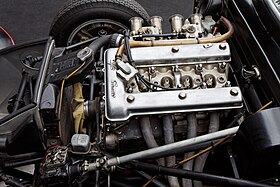
Alfa Romeo Automobiles S.p.A. is an Italian luxury car manufacturer and a subsidiary of Stellantis Europe. It was founded on 24 June 1910 in Milan, Italy, as A.L.F.A., an acronym for Anonima Lombarda Fabbrica Automobili. The brand is known for sport-oriented vehicles and has been involved in car racing since 1911. As of 2023 it is a subsidiary of the multinational automotive manufacturing corporation Stellantis.
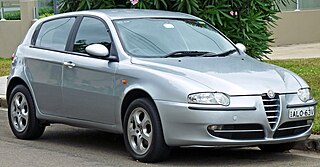
The Alfa Romeo 147 is a small family car produced by the Italian automaker Alfa Romeo from 2000 to 2010. The 147 was voted European Car of the Year in 2001.
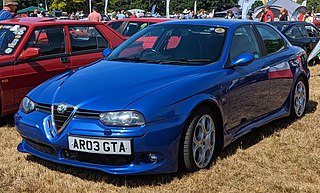
The Alfa Romeo 156 is a compact executive car produced by the Italian automobile manufacturer Alfa Romeo. It was introduced at the 1997 Frankfurt Motor Show as the replacement for the Alfa Romeo 155. The 156 received a positive reception and in the following year went on to win the 1998 European Car of the Year award. The 156 saloon was discontinued in Europe late in 2005, while the Q4 Crosswagon continued in production until the end of 2007.

In automotive engineering a multi-valve or multivalve engine is one where each cylinder has more than two valves. A multi-valve engine has better breathing and may be able to operate at higher revolutions per minute (RPM) than a two-valve engine, delivering more power.

Alfa Romeo Twin Spark (TS) technology was used for the first time in the Alfa Romeo Grand Prix car in 1914. In the early 1960s it was used in their race cars (GTA, TZ) to enable it to achieve a higher power output from its engines. And in the early and middle 1980s, Alfa Romeo incorporated this technology into their road cars to enhance their performance and to comply with stricter emission controls.

The Lancia Flat-4 engine is an aluminum, pushrod, and later overhead camshaft, flat-four (boxer) engine made by Lancia, initially for the Flavia, from 1960 through 1984. Though it was designed as a pushrod engine, it was advanced for the time. The pushrod version of the Lancia boxer was only ever used in the Flavia, and its derivatives including the Lancia 2000. In 1976, a new overhead cam engine based on a similar layout was designed and brought into production in 2 and 2.5-litre displacements for the Gamma.

Alfa Romeo Giulia is the name of three not directly related models by the Italian car manufacturer Alfa Romeo. The first is a line of sporty four-door compact executive cars produced from 1962 to 1978, the second is an updated, mainly up-engined Spider, Sprint and Sprint Speciale Giuliettas, and the third Giulia is a compact executive car unveiled in 2015.

The Alfa Romeo GTA is a coupé automobile manufactured by the Italian manufacturer Alfa Romeo from 1965 to 1971. It was made for racing (Corsa) and road use (Stradale).

The Alfa Romeo Alfetta is a front-engine, five-passenger sedan and fastback coupé manufactured and marketed by Alfa Romeo from 1972 to 1987 with a production total over 400,000.

The JTS engine is a gasoline direct injection engine produced by Alfa Romeo. It exists in two forms, straight-4 and V6, and was introduced into the Alfa lineup in 2002.
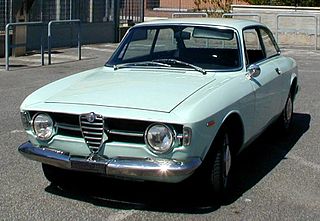
The Alfa Romeo 105 and 115 series coupés are a range of cars made by the Italian manufacturer Alfa Romeo from 1963 until 1977, based on a shortened floorpan from the Giulia saloon. They were the successors to the Giulietta Sprint coupé.

The Alfa Romeo V6 engine is a 60° V6 engine made by Alfa Romeo from 1979 to 2005. It was developed in the early 1970s by Giuseppe Busso, and first used on the Alfa 6 with a displacement of 2.5 L (2,492 cc) and a SOHC 12-valve cylinder head. Later versions ranged from 1,996 to 3,179 cc and had DOHC 24-valve valvetrains. The original design had short pushrods for the exhaust valves in a design similar to earlier Lancia Fulvia engines. The first DOHC version was in the 1993 Alfa Romeo 164, with an aluminium alloy engine block and head with sodium filled exhaust valves.

The Alfa Romeo Giulietta is a family of automobiles made by Italian car manufacturer Alfa Romeo from 1954 until 1965 which included a 2+2 coupé, four-door saloon, estate, spider, Sprint, and Sprint Speciale. The 2+2 was Alfa Romeo's first successful foray into the 1.3-litre class. From 1954 to 1965 a total of 177,690 Giuliettas were made, the great majority in saloon (Berlina), Sprint coupé, or Spider body styles, but also as Sprint Speciale and Sprint Zagato coupés, and the rare Promiscua estate.
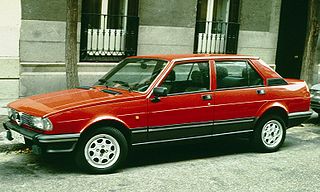
The Alfa Romeo Giulietta is a small executive saloon car manufactured by Italian car maker Alfa Romeo from 1977 to 1985. The car was introduced in November 1977 and while it took its name from the original Giulietta of 1954 to 1965, it was a new design based on the Alfa Romeo Alfetta chassis. The Giulietta went through two facelifts, the first in 1981 and the second one in 1983. All Giuliettas used 5-speed manual transmissions.
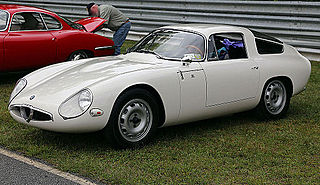
The Alfa Romeo Giulia TZ was a sports car and racing car manufactured by Alfa Romeo from 1963 to 1967. It replaced the Giulietta SZ. In 2011, the name was reduced from Giulia TZ to TZ in the new TZ3 model.

Giuseppe Busso was an Italian mechanical and engine designer mostly known for his tenure at Alfa Romeo and Ferrari.
Variable valve timing (VVT) is a system for varying the valve opening of an internal combustion engine. This allows the engine to deliver high power, but also to work tractably and efficiently at low power. There are many systems for VVT, which involve changing either the relative timing, duration or opening of the engine's inlet and exhaust valves.

The Fiat Pratola Serra modular engines are a family of engines produced by the Fiat Group since 1994 and used in Fiat, Alfa Romeo, Lancia and Jeep vehicles. They are named after the Pratola Serra municipality in which they're being produced.
